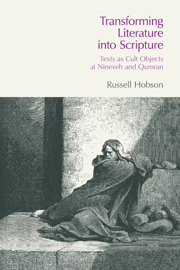Book contents
- Frontmatter
- Contents
- Acknowledgements
- Abbreviations
- 1 Authoritative Texts in the Hebrew and Cuneiform Traditions
- 2 Formulating a New Comparative Approach
- 3 Choosing the Right Texts
- 4 Study One: Enūma Anu Enlil Tablet 63
- 5 Study Two: Mul.Apin
- 6 Study Three: The Laws of Hammurabi
- 7 Study Four: Tablet XI of the Epic of Gilgamesh
- 8 Study Five: Mīs Pî
- 9 Study Six: Manuscripts of Pentateuchal Texts from Near the Dead Sea
- 10 Interpreting the Evidence
- Notes
- Bibliography
- Index of Ancient References
- Index of Authors
- Index of Subjects
8 - Study Five: Mīs Pî
- Frontmatter
- Contents
- Acknowledgements
- Abbreviations
- 1 Authoritative Texts in the Hebrew and Cuneiform Traditions
- 2 Formulating a New Comparative Approach
- 3 Choosing the Right Texts
- 4 Study One: Enūma Anu Enlil Tablet 63
- 5 Study Two: Mul.Apin
- 6 Study Three: The Laws of Hammurabi
- 7 Study Four: Tablet XI of the Epic of Gilgamesh
- 8 Study Five: Mīs Pî
- 9 Study Six: Manuscripts of Pentateuchal Texts from Near the Dead Sea
- 10 Interpreting the Evidence
- Notes
- Bibliography
- Index of Ancient References
- Index of Authors
- Index of Subjects
Summary
The Text
The ritual of Mīs Pî, “washing the mouth,” was an ancient Mesopotamian cultic practice by which material representations of deities, namely three-dimensional statues, were imbued with divine presence before being stationed in their respective temples. While the practice of inducting a manufactured image of a deity for worship in a temple is known from the third millennium bce, cuneiform sources for the textual form of the ritual come only from the first millennium bce. The mouth-washing ritual consists of a list of instructions, which also has placed throughout it the incipits of incantations that are to be read at certain times throughout the rite. The full incantations are contained in a separate series of tablets.
The ritual exists in two major recensions, each having a slightly different order of ritual acts and a differing number of incantations. The divergences in the recensions are seen most readily in the differences between the ritual tablets from Nineveh and those from Babylon. The entire series as we have it is composed of eight incantation tablets at Nineveh, six at Babylon, and in each a final tablet that supplies instructions for performing certain actions, and prompts for reciting the incantations. It is the sources for the tablet containing the ritual instructions from Nineveh that will be the topic of examination here. The incantation tablets will not be considered.
- Type
- Chapter
- Information
- Transforming Literature into ScriptureTexts as Cult Objects at Ninevah and Qumran, pp. 89 - 99Publisher: Acumen PublishingPrint publication year: 2012



